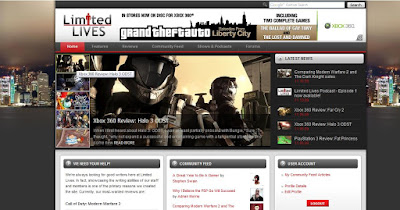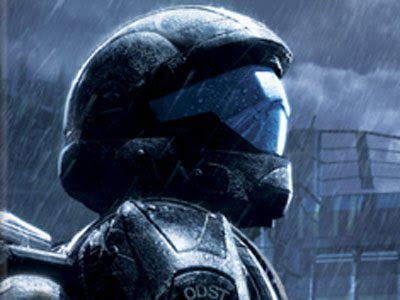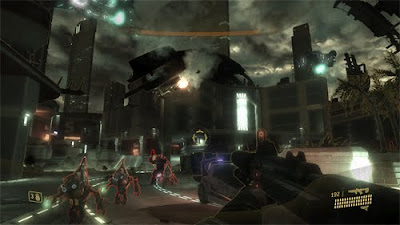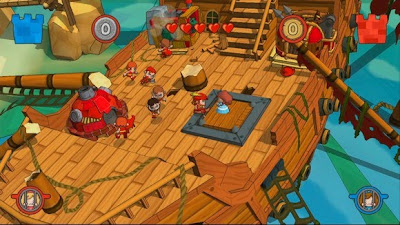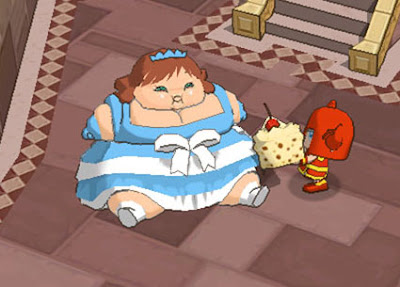So I'm writing this rougly 6 or so months after limited lives launch, and it's safe to say that site is dead. However, what myself and the other reviews from this blog believe in and want to do has not. I have some un-aired podcasts that are recent up to E3 2010 that I would like to post here to continue what we've been working on.
Yes, there is a new site in the works that builds from what we've learned on this blog and with limited lives. I'm not sure exactly how everything will work yet, but we've focused it more on writing from outside our staff and more media content from our side. This will fix most of our problems we've had working on limited lives.
I hope you'll enjoy these next few podcast posts, and I have to say thanks for visiting. Over this month I'll be reporting on what took our attention away from limited lives, onto a bigger project fused with a larger undertaking, and how it deals with limited lives and the new websites future.
Thanks,
Adrian
Thursday, July 1, 2010
Saturday, December 19, 2009
Back
So this is short, hopefully everyone is using limited lives, but if your new and checking back i've got some suprises and it'll deal with a complete makeover for the limited lives and our podcasts, i can't wait to tell you all about it. Expect something solid in early Feb. So, keep on checking back and hitting up the Limited Lives website.
Thanks
Tuesday, November 17, 2009
LIMITED LIVES IS HERE!~
.png)
While the site has launched, it's also still under some construction. However, it's pretty much solid. So here's what you'll want to do, go to the Limited Lives website and make an account. After that, you're good to go. Set up your profile, check out some of the reviews and listen to the podcast, while listening to this weeks podcast episode.
It's all that simple. Everything is now conveniently located. Wait I forgot to mention the most important part. You are now able to write for us. That's right, blog your own features, reviews, opinions, top 10 lists, ect. The topics go on and on. We'll be posting submissions guidelines on how to do that this week, but honestly just write and if it's good enough, it'll make the front page.
In order to submit it for review/edit by our editors, all you have to do is mark your blog post as "unpublished" and it'll enter our system for us to take a look at it.
Also, if you want to know what reviews we need, just look at the front page under "we need your help!"
Also, check out the forums, make them lively, chat up a storm, you know, or even suggest new topics for the podcast.
I hope you'll enjoy the site, everyone (mainly Andrew) put their heart and soul into it.
Now, this weeks podcast which grant will be somewhat old, deals with some details about the site, Borderlands, Trine, our games for this Christmas, and the DSi XL/LL.
All podcasts and articles will be available via Limited Lives only. I'll be posting snips and updates through the blog so don't abandon it yet lol.
Sunday, November 1, 2009
ABXY Podcast #18~ Uncharted 2, Storytelling, and Limited Lives next week!

I'm pleased to announce to end of ABXY Podcast. Next week, get ready for Limited Lives because yes....it's Official~
This weeks podcast is short form and all topic. The topic is story telling in gaming and how it's evolved. We've got matt, myself, andrew, tiara, and steven, so I hope you enjoy, and I hope you're prepared for next week's epicness.
Xbox 360 Review: Far Cry 2

For as long as I call myself a gamer, the Far Cry franchise will hold a special place in my heart. I cannot call myself a diehard fan, as I have played only Far Cry Instincts and Predator (both, conveniently, on one disc). However, I logged more hours on those games than many others in my library, largely because of the addicting map editor, but also because the story was attractive enough to make me develop a fondness for the main character and the exotic places to which the game carried me ).
So I was immediately intrigued when I saw a magazine article about Far Cry 2 and read the entire article, as well as any I could find online, topping off my casual mania with the first pre-order in my time as a gamer. When release day came, I happily collected my copy and eagerly loaded the game into the console. Far Cry 2 is set in wilds of Africa, a somewhat exotic locale for a mainstream videogame, and one which did not disappoint . In the intro scene — a first-person, mood-setting ride through the savannah — the player takes in the flowing, amber hills and sage-green brush, as well as some ominous signs about what is in store for the player . As you are chauffeured towards a small town, you are subjected to a one-sided conversation with a guide, who laments the violence between two warring factions and the difficulty of civilians leaving the war-torn, unnamed nation. As the guide rambles on, evidence of the conflict appears along the road: burning shacks, wildfires and, in one particularly tense moment, a faction-controlled checkpoint that the guide bribes in exchange for safe passage.

Far Cry 2 is a free-roaming game, much like previous sandbox-style games such as the Grand Theft Auto Series. Players have substantial flexibility in how they approach missions and are free to select the weapons, routes and even time of day they wish to attack. One thing that is different from other similar games is that instead of provoking responses from enemy forces that start at ”timid resistance” and eventually reach ”ridiculous armada of tanks, helicopters, etc,,“ Far Cry places faction camps at crossroads and other important areas that you must scheme around. You can either attempt to sneak past, strike guerilla-style and thin their numbers or attack them head on. The stealth option can be difficult, as the AI occasionally seems too difficult to fool, but this just means that you must always be prepared to blast your way out if need be. You can also scream through in a high-speed buggy and watch them scramble to chase you in their assault trucks while you set up on a hill with a sniper rifle or rocket launcher.
Things get really interesting when you decide to start a brushfire, which you can do via a surprising number of options — a flare gun, flamethrower or the back-blast of a rocket-launcher — and watch the enemy get caught in the raging wave. Unfortunately, this game element is not as destructive as you might think, and sometimes you will simply find yourself in an old-fashioned firefight while your brushfire withers among the buildings or decides, as brushfires are want to do, to parade off into the savannah as opposed to barbequing your prey.

The health system is unique and is one of my favorites so far. You have a health bar which is cut into a number of segments. Health within these segments regenerates, but it can only fill up to the next segment. Players carry around a number of morphine syringes, which can be used to replenish all of the segments at once (apparently without risk of overdose, which is good, because you’re going to poke yourself with them so many times in the course of an hour that you could start naming constellations on your forearm).
However, if you get within the danger zone of the last two bars, you start to bleed out, and must subject yourself to improvisational medical care. Sometimes you pull a bullet out with your teeth. Other times you put gauze on a burn. Still others you will actually snap bones back into place and continue on your merry way. It’s closer to realistic than magically auto-healing Call of Duty style, but it does place the player in the list of super-manly men from Mars every time he casually yanks rebar out of his midriff.
No, that is not hyperbole. That is an actual healing sequence.
Ironically, this health system does not prove to be clunky, despite its seemingly complex nature. Even within multiplayer, which has an only slightly different version , it leads to tense, even epic situations in which you gun down two people with an auto-shotgun, heal your wounds in a hut and then maul someone trying to capitalize on your wounds with a sub-machinegun. You will get gunned down just seconds before you are healed more than once, but it rarely becomes grating.
On that note, multiplayer is done fairly well, with weapons that demonstrate the developers made earnest attempts at balancing the experience, but did not succeed to the degree we are used to in this generation. This is probably because of the nature of the weapons, which come in three tiers per class, minus the special weapons, with the last tier being absurdly powerful.
One problem in particular is that a few basic weapons seem to reign supreme, while others have no value beyond style points. On most maps, decent snipers, especially one wielding the .50 caliber that can be quickly unlocked, can make being in the open extremely risky. This is a problem, seeing as many of the maps have large, open, hilly areas, characteristic of the savannah. This problem is compounded by the fact that the .50 caliber is a one-hit down and astoundingly accurate when fired from the hip, meaning that even an auto-shotgun ambush can fail with a single, well-placed shot.
The flamethrower, though devastating in campaign, is a very risky weapon of choice on all but a few maps. The enemy only takes damage from being set alight, and any follow-up blasting is a waste of time, except maybe to blind the enemy while you scramble for cover, hoping that they roast before they find you. This was especially disappointing to me, though I understand it to a degree, because I have a veritable fetish for flamethrowers. Finally, the basic class, which begins with an assault rifle, is somewhat overpowered in most scenarios, and outlandishly so once the grenade launcher sidearm is unlocked. The grenade launchers in general, as there is also a four-round, high speed, sniper-accurate grenade launcher to be unlocked, make Far Cry 2 multiplayer a bit more of a painful, nerve-wracking and abrupt experience than it should be, at least for anyone like me who refused, perhaps foolishly, to jump on that particular bandwagon.
Overall, it is exceedingly well done, with successful new ideas, excellent story elements and only a few clunky features. But some part of our gamer nature plays with the new toys, tires of them (at least for awhile) and dreams of what the next next-generation game can do to make it better.
Rating: A
Platforms: Xbox 360, PC, PlayStation 3
Price: $59.99
ESRB: M for Mature
Pub: Ubisoft
Dev: Ubisoft Montreal
Players: 1
Xbox 360 Review: Halo 3 ODST
The shame of Bungie’s expensive expansion
When I first heard about Halo 3: ODST, I was at least partially onboard with Bungie. “Sure,” I thought, “why not expand a successful and entertaining game with a tangential story line and some new content? Twenty bucks not utterly wasted, I guess.” I was slightly less onboard after seeing the $60 price tag. And I was well sick of Bungie by the time I realized I was playing Halo 3 cleverly disguised as original content.
A good first-person shooter like Call of Duty 4 for example can easily balance the need for inventive game play with the desire to create an interesting story and characters. However, ODST abandons both goals in favor of bland, virtually undeveloped characters and game play so eerily similar to Halo 3 you could swear it was running on the same engine with the same enemies and weapons. Granted, players get a scoped, suppressed SMG and an upgraded pistol that magically headshots an enemy when aimed in their general direction, but both are essentially minor tweaks of existing weapons.
For $60, I think I deserve something more than Halo 3 with new box art and minor tweaks. One would think Bungie could take time from fleecing its loyal fans and make a new melee weapon or over-the-top explosive. For that matter, they could also have tried improving the graphics on a new iteration of the series; the armor and environments, particularly in cutscenes, are done in an olive drab-and-brown “next-gen” filter and things that should be light and airy, such as hair, are flat, poorly textured blobs.
The story, though emotionally unmoving, is told like a novel. You, the nameless, faceless “Rookie” with no personality or voice, act as a detective, unraveling the fates of your squad by finding clues strewn about the battlefield while occasionally winding up in small skirmishes. These scenes were, by far, my favorite parts of the game, as the pitch black city, haunting background music and ability to sneak past resting enemies create a very unnerving and surprisingly engrossing environment. Each clue found by the Rookie brings you to a flashback, in which you play through the adventures of your scattered squad mates. Sadly, these missions are dismally boring, as your squad mates do little more than interact with each other with all the emotions of unpaid extras in a b-grade horror movie, all while killing aliens on missions of no discernable importance. Upon reaching the end of the campaign, I had the distinct feeling I had made no impact on anyone’s life and my four or five hours of blasting aliens in cookie-cutter corridors had not affected the fate of the universe in the least. So much for the “epic” feel of the Halo series.
To be fair, ODST does have at least two interesting gameplay innovations worth mentioning. The first only appears during campaign and Firefight mode: the VISR. Whereas the “X” button was used to deploy special items, it now turns on a light-amplification and target-identification HUD. This feature is useful for navigating the numerous night maps and dimly lit corridors in the campaign.
Another new feature, Firefight mode, allows one to four players to cooperatively defend a position against wave after wave of alien death. Exciting as it sounds, the whole experience lacks any sense of urgency. Areas are wide-open, allowing ample time to snipe all the smaller enemies with your pistol before they can even react. Even when left to their own devices, enemies are not prone to rushing your position, but will sit patiently and shoot at your well-defended position, except the hammer-wielding aliens who will destroy you with ease as they absorb clip after clip of SMG ammo. Firefight is fun enough, especially with more players, but it could have benefited from the inclusion of more powerful weapons and enemies, or just by the addition of some vehicles to the maps to liven the experience up.
Despite this ODST’s abundant flaws, overpriced content and short campaign mode, there is still something entertaining about it, no matter how badly anyone wants to hate it. I found myself thrilled by murdering an alien twice my size with a rifle butt to the face. As slow-paced as Firefight can be, I felt compelled to work for a new high score and see how many headshots I could get with the pistol. The multiplayer, which is on a separate disc from the campaign and Firefight, is Halo 3’s map packs along with three brand-new maps and it’s every bit as solid as before. It’s definitely the reason to own any Halo game. However, I could get the same amount of entertainment and repetitive game play for half the price with an old copy of Halo 3.
Rating: C-
Platform: Xbox 360
Price: $59.99
ESRB: M
Publisher: Microsoft Game Studios
Developer: Bungie
Players: 1-4 (firefight, campaign), 2-16 (multiplayer)
PlayStation 3 Review: Fat Princess
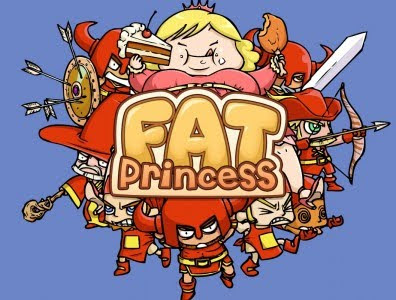
Note: Reviewed before Patch
Who says all princesses are skinny?
Fat Princess is a PlayStation Network exclusive that really tailors itself to the multiplayer community. The heart of the game is capture the capture the flag-style gameplay (with a princess as the flag) combined with class structure-type game play. Since the princess is the objective, the main way a team can make it difficult for the opponent to capture her is to feed her cake, making her fatter and more difficult for one person to carry. This game mechanic really lends itself to well-formed teams that can upgrade facilities like jobs and catapults while fattening up the princess and assaulting the enemy.
Multiplayer and single player host a variety of modes on a great selection of maps. Modes include capture the princess, deathmatch, invasion and a soccer mode. All except the soccer mode are available on almost all maps. The maps are innovative, varied in style and quite balanced for the types of play. Maps contain resources that can be farmed for each team’s castle, and smaller outposts that can be captured for a strategic advantage.
Worker, age, priest, and archer are the five distinctive classes each team has at its disposal. Each class is accessed via hat factories within each team’s castle. A player simply has to put on a different hat to assume a different role. Hats can also be picked up in the field as other players die. The hat factories are upgradeable via the wood and metal upgrades scattered across the map, and each class has one upgrade. The upgrades allow players to switch back and forth between iterations of the same class to have different effects in battle. For example, the can switch between fire and ice upgrades to cause continual damage on foes or just freeze them in place so teammates can more easily hit them. The worker class is the main source of mining upgrades, which, after farming, can be taken back to a captured outpost or castle to be used in upgrades.
Multiplayer matches support up to 32 players with 16 players on each side. Matchmaking is handled intelligently by the game, as weaker connections are not allowed to host more than the connection can handle and, if the host connection is lost, the game will automatically try to find the next best connection instead of kicking everyone in the game. Players can jump into the same game as those on their friends list or players can forgo the specific match choices with the “Jump In” option.
Multiplayer is really where this game shines. Sixteen vs. 16 person play can become a bit chaotic at times, but overall, the game is extremely enjoyable, especially when played with a group of people who all have headsets for voice chat. Unfortunately, one downside of multiplayer is the inescapable stalemates that arise every game. Matches can go on for at least 20 to 30 minutes if players are not well-organized and just end up fighting in one ball in the center of the map. Again, headsets are what make this game shine as even a small, organized group of players can thwart even larger numbers of enemies.
The single-player component of Fat Princess is quite forgettable. It does put a cute back-story to the game, but to get through the story, the player must endure the same stalemated matches with stupid AI (often seen standing around the battlefield) for eight battles. Beating the single-player mode unlocks some customizable parts of your player and a trophy, but the single player is still rather underwhelming when compared to the multiplayer experience.
Fat Princess is a truly enjoyable game on the multiplayer side. Some other issues like unbalanced classes — the and age in particular — are the cause of some annoyance, but the aesthetics of this unique game truly make it shine. Players login to the game and are greeted with several humorous options such as “Twiddly Knobs” and “Play With Yourself,” and the style is further accented by the cute characters killing each other in extremely bloody fashion. These visual options can be turned off, but doing so significantly takes away from the experience.
Despite slow-paced single player, frequently stalemated online matches and slightly unbalanced class structure, Fat Princess is a excellent game. Its style is unique and its game play fun enough to easily overlook the game’s flaws. If you have a PS3 and a headset, this game is a must buy — especially if you have friends who have it.
Grade: B
Platform: PlayStation 3>PlayStation Network
Price: $19.99
ESRB: T for Teen
Publisher: Sony Computer Entertainment
Developer: Titan Studios
Players: 1-32 (online)
Subscribe to:
Posts (Atom)

